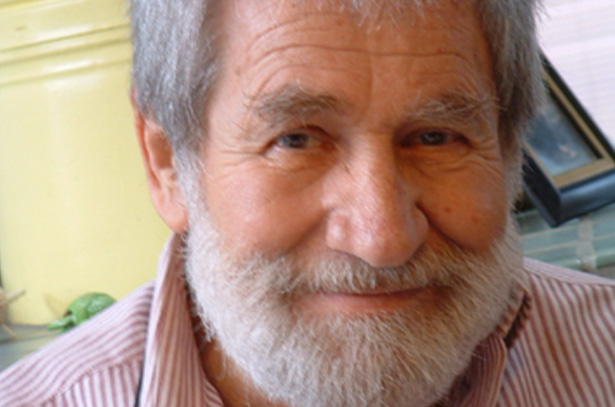Allan Kaprow is known as the inventor of Happenings, a term he coined in New York in 1958. With their lack of dramatic plot, the collage-like, often simultaneous organization of events, the blurring of boundaries between performers and the audience, their appeal to the senses, an openness to chance and improvisation, and the everyday settings in which they took place, Happenings were hybrid forms of vanguard performance in which various arts media (painting, music, dance, theater) were disguised as ordinary things (newspaper, noise, body movements, common tasks) and composed together as quasi-theatrical events. At the same time, Kaprow pioneered room-filling works he called Environments. Conceptual predecessors of Happenings, Environments entangled spectators in multi-sensory experiences – like being inside a work of art – and literally set the stage for his Happenings. Often, the Environments offered choices to visitors, like selecting between a fake and a real apple, moving furniture around a room, throwing tires, aligning words on walls to make sense or nonsense; the enactment of these choices, in turn, helped constitute the 'happenings' of the Happenings. By 1963, the Happenings had become more mobile, less anchored in their physical settings, and the Environments dropped away from Kaprow’s practice. From 27 August to 8 October, 2005, Hauser & Wirth Zurich will present two reinvented works by Allan Kaprow, one Happening – 'Sawdust' 1970 – and one Environment – 'Words' 1962. In addition, documentation will also be shown from 'Fluids' 2005, (original version 1967) a Happening enacted at Art Basel in which three ice-block enclosures were erected in different locations by teams of participants, and then allowed to melt. “Sawdust” was first carried out in conjunction with the exhibition Happenings and Fluxus at the Kölnischer Kunstverein in Cologne, in November 1970. There, participants reserved time at a local carpentry shop and shaved a wooden beam, one saw blade width at a time, into sawdust. The sawdust was then mixed with glue and poured into a mold where it hardened back into a wooden beam – which was subsequently exhibited in the Happenings and Fluxus show. Kaprow saw his reconstituted beam as a symbolic bridge between the carpentry shop and the museum, thereby giving the museum the object it needed — a kind of mock object — while giving participants an experience of first reducing it to sawdust. For its Zurich enactment, which will be overseen by local carpenters, 'Sawdust' will involve shaving wooden beams into sawdust, as before. This time, however, the shavings will be mixed with glue and shaped into floor boards that will eventually cover the floor of the gallery. Visitors to the gallery will be invited to participate in this process, which will be ongoing until completed. 'Words' was first realized in September 1962 in two small rooms built in the Smolin Gallery in New York City. The walls of the first room were covered randomly with words that were hand lettered on pieces of paper or stenciled on rolls of canvas, and which could be added-to by visitors and read in any order or direction. Three record players of words recited by Kaprow could be played singly or together. Red and white light bulbs flashed on and off along the tops of the walls. The walls of the other, somewhat smaller room were dark blue and covered by graffiti. Colored chalk, hung from strings, allowed visitors to draw pictures and write messages. The entire space was filled with strips torn from bed sheets suspended from the ceiling, each clipped with a piece of blank paper to write on. On the floor was a phonograph playing whispers that could only be heard by kneeling down. For Kaprow in 1962, words were physical fragments of the urban environment, a quasi-architecture of marks, signs, notes, doodles, carvings, scrawls, shouts, and whispers. 'I am involved,' he wrote, 'with the city atmosphere of billboards, newspapers, scrawled pavements and alley walls … whispered secrets, pitchmen in Times Square, fun-parlors, bits of stories in conversations overheard at the Automat.' In a poignant contrast to the raw physicality and crude visual style of the urban language surrounding the artist in 1962, 'Words' 2005 will be a more ephemeral work, composed entirely of sound. Its visual and material aspects stripped away, the Zurich reinvention of this famous Environment is more cerebral, and may attest not only to the passage of four decades – a metaphor, perhaps, for the artist’s own aging – but also to the disembodied state of language that typifies our expanded global 'environment' today. Throughout his career, Kaprow – now 78 – has reinvented certain Environments and Happenings in order to bring them back from the domain of art history (and rumor and gossip) and into the present moment of the participant. While the underlying metaphors of each work are maintained – for 'Sawdust,' one thinks of absurdist work; for 'Words,' language as a form of the environment – their reinvention permits an unpredictable experience and a constantly changing phenomenon. By helping enact these works, participants keep them vital as instances of life-like art. Jeff Kelley The exhibition is accompanied by the new publication 'Allan Kaprow. Fluids', Verlag der Buchhandlung Walther Koenig, Cologne. American critic Jeff Kelley is the author of 'Childsplay. The Art of Allan Kaprow' (University of California Press, 2004), the most comprehensive monograph on Allan Kaprow’s work to date.













